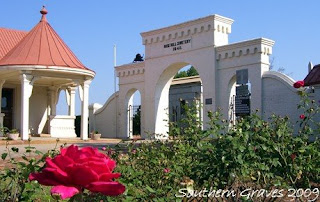 Rose Hill Cemetery is located on Riverside Drive in Macon, Bibb County, Georgia. It is an example of a 19th century rural cemetery park, and it is on the National Register of Historic Places.
Rose Hill Cemetery is located on Riverside Drive in Macon, Bibb County, Georgia. It is an example of a 19th century rural cemetery park, and it is on the National Register of Historic Places.The main man behind Rose Hill Cemetery was Simri Rose. He was the sixth son of Levi and Mary Rose. He was born in Connecticut and migrated to Georgia about 1818. He died 3 April 1869.
Simri Rose selected and laid out Rose Hill Cemetery. He was also on the first cemetery committee.
Lots in the Rose Hill Cemetery went on sale about May 1840. They were no smaller than 20 square feet and no larger than 40 square feet. Prices ranged from $5 - $30. Lots were auctioned at public sale from time to time, and free lots could also be given to those who improved them according to instructions by the cemetery committee.
At that early time, no tombs were allowed. All interments had to be in underground vaults or coffins. No lot was to be cleared of forest growth, except with permission of the committee.
By 1841, Simri Rose had divided the 50 acre site into five distinct sections: Central Avenue District, Eglantine Square, Forest Hill, Magnolia Ridge, and Holly Ridge.
Originally, each of the sections was separated by thick woodland. But, as the city of Macon grew, so did the cemetery. In 1850, a sixth section, Pine Ridge, was added. Furthermore, in 1856 and 1857, Hawthorne Ridge, Honeysuckle Ridge, and Ivy Ridge was added.
In 1848, immediately west of Rose Hill, Simri planned Oak Ridge Cemetery. This was to be for slaves.
In 1851, it became necessary to lock the entrance gate to Rose Hill to prevent livestock from entering.
In 1859, the Macon City Council commented, "Our cemetery has most justly become a special object of interest and pride to our citizens, and the attraction of many who reside far beyond our limits, many of whom are securing family burial places in it, and many during the last year have been brought from great distances to be deposited in its bosom as their last mortal resting place."
In 1862, the cemetery charter was altered to allow smaller plot sizes. The new maximum size was 30 X 25 feet, and fractional lots were permitted. No longer was a free lot able to be obtained.
Union troops during the Civil War did some damage to the cemetery. Fences, trees, and shrubs were cut down. Soldiers bathed in the lakes, and several crystaline rocks were stolen.
At the end of the war 27,000 square feet was set aside for more than 600 Confederate soldiers. It was the flank of a hill sloping toward the Ocmulgee River, and it was named Soldiers Square.
In 1870, a subdivision was sold to the Beth Israel Congregation and given the name William Wolff Cemetery. Some time later, Cabiness Ridge was established.
In the late 1890s, the Roman Catholic Church acquired what was named St. Joseph Cemetery.
By 1959, the following subdivisions had been added: The Terraces, Lakeside Terrace, Triangle Square, and Carnation Ridge.
Source:
Rose Hill Cemetery: Derivation, Development, Degeneration
by Bruce W. Earnheart, © 1989

No comments:
Post a Comment